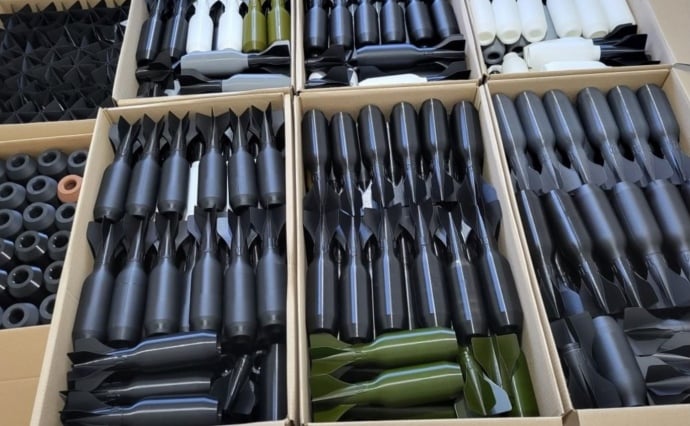

"DrykArmy" products. Photo: epravda
Epravda reports that.
What is the problem?
The military always seeks cost-effective solutions for producing items such as drone shells, mines, medical equipment, rifle parts, radios, and drones. With a 3D printer, a grenade can be transformed into a drone shell, and a simple quadcopter can become a bomber.
Since 2014, volunteers have been producing these goods in Ukraine for their military comrades. However, small groups of printers are no longer sufficient. To meet the army's demands, millions of accurately crafted parts and shells are required, delivered to the front in a timely manner.
What is the solution?
Some volunteers had an idea to bring together all individuals with printers and operate as a single defense factory by:
Compassionate Ukrainians started this movement, and now, it is manifested as "DrukArmy" [Print Army in Ukrainian – ed.] —an innovative platform that has transformed ordinary printers into a means of producing defense materials.
How does it work?
"During the Second World War, women and children stood at the machines and made ammunition. We are not in a better situation now, so a 3D printer should be in every Ukrainian house," the head of "DrukArmy" Mykyta Kuvikov, better known under the pseudonym Yevhen Volnov, said.
Yevhen Volnov. Photo: epravda
Over the past two years, the organization has:
"DrukArmy" united over 10,000 printers, which now print and deliver hundreds of thousands of parts to the front weekly.
According to Kuvikov, the process is automated, allowing the military to order necessary parts through an online platform and providing printers with patterns and instructions for production.
Layouts of "DrukArmy." Photo: epravda
Approximately 3,000 printers in the community are currently available to accept new orders. Over 15,000 military personnel have joined the platform and can select the necessary products for their unit from our free catalog.
The "DrukArmy" catalog contains approximately 500 unique products, most of which were designed by its team. The dedicated group of volunteer engineers with expertise in 3D modeling is responsible for research and development. Usually, the development process starts with a request from the military, who then test the prototype in the field and provide feedback.
Competition with resellers
Due to the generous donations towards the acquisition of raw materials and the financial aid from the partners, "DrukArmy" functions on the following basis: products are either given to the military for free or sold at the cost of materials.
Photo: epravda
On the other hand, there are entrepreneurs who raise the prices of 3D-printed products, prompting volunteers to step in and offer more affordable and top-notch products to compete against these inflated prices.
Learning, coordination, innovation
One component of the "DrukArmy" initiative involves training novice printer operators. The organization has extensively designed instructions, lectures, and resources to aid individuals in mastering the skills needed to operate 3D printers, including selecting appropriate models and materials. This enables individuals with varying levels of experience to contribute efficiently to the production of essential goods.
Among the members of "DrukArmy" are individuals from different age groups and occupations. Whether students or retirement-aged, each printer is capable of fulfilling orders, resulting in cost savings for military units.
Even foreigners join the ranks of the "DrukArmy." Transporting products from abroad is not very profitable, but people do it anyway.
"This is psychology. You make a physical object with your own hands that kills a p…a [swear words used to refer to a Russian occupier – ed.]. This makes you involved in a big cause," the volunteer believes.
The entry threshold into this activity is relatively low: a basic printer costs UAH 10,000, and plastic costs UAH 350 per kilogram.
"One kilogram of plastic is 15 parts for "dropping" grenades, each of which can hit the occupier," Volnov says.
A new user must register on the site.
On the way to mass production
DrukArmy has already supplied the army with over 275 tons of 3D-printed parts, and this trend is rapidly gaining traction. These parts include:
Currently, the "DrukArmy" is storing products in warehouses, preparing for large-scale power outages. When production slows during winter, the most in-demand items will be distributed from pre-prepared stock.
The organization is expanding its focus beyond printing, bringing together volunteers with skills in net weaving, electronic soldering, and working with more advanced tools.
Even though there isn't sufficient material for production, the volunteers refuse to give up because every gram of plastic translates into tangible aid for the defenders of Ukraine. You are welcome to donate to the plastic collection here.
У межах ініціативи Президента України Bring Kids Back UA вдалося повернути ще 11 українських дітей… Читати більше
У Києві у галереї "Хлібня" Національного заповідника "Софія Київська" відкрилася експозиція унікальної колекції півників Васильківського майолікового… Читати більше
У Білому домі гостро відреагували на повідомлення ЗМІ про звільнення американського бізнесмена Ілона Маска з… Читати більше
У березні Україна експортувала товарів на понад $3,6 млрд — це на 4,5% більше, ніж… Читати більше
Національний природний парк «Бойківщина» показав кадри з місцевим «карпатським єдинорогом». По це йдеться у повідомленні нацпарку, пише Рубрика.… Читати більше
Бойовий модуль українського виробництва Wolly з дистанційним керуванням та штучним інтелектом, на який встановлюється кулемет… Читати більше
Цей сайт використовує Cookies.